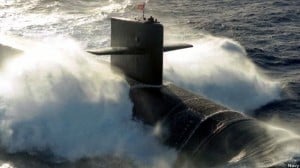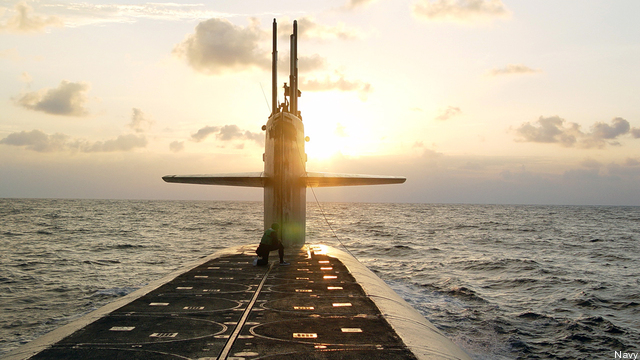National Sea-Based Deterrence Fund: Myth vs. Reality
Posted on
The Navy’s nuclear ballistic submarine replacement is coming online in next year’s budget and the bill will be huge. It is so big, in fact, that Congress has already established a special account outside the normal shipbuilding budget to help ease financial pressure and not disrupt almost every other ship coming under construction.
While the concept is not new to create a special fund for nuclear assets, it is irrelevant without a higher defense budget topline. That’s because the money to pay for the Ohio Replacement Program (ORP) is still green. And with a flat defense budget for the foreseeable future, that money will hurt other equally important priorities across the US military.
Congress’ National Sea-Based Deterrence Fund is just an accounting gimmick—even in the words of Pentagon officials. The real effort to buy the boats smarter and with better contracting tools that favor the government customer and save taxpayer money is sound. The secret no one’s talking about is that this can be done without the existence of any “special fund.”
But the real consequence of hurting the Army and Air Force to pay for upgrading this leg of the triad is deleterious and should be killed. Quickly.

Myth: The National Sea-Based Deterrence Fund is just like earlier “special funds.”
Fact: The Deterrence Fund is an historically atypical funding mechanism.
It’s true that the Pentagon has used “special funds” before for the procurement of equipment that truly supports the entire Defense Department. For example, Congressional Research Service shipbuilding expert Ronald O’Rourke has cited the National Defense Sealift Fund for the Navy’s massive cargo ships that support American military operations overseas. A key staffer in the drafting of the Deterrent Fund told Breaking Defense they explicitly modeled it on the Sealift Fund.
O’Rourke also points to the funding of large parts of the ballistic missile defense program through defense-wide procurement accounts, a workaround that applies largely to Navy and Army activities. And yet the Air Force procures and operates the entirety of the satellite constellation in its own budget—a capability that not only enables the joint force, but also underpins a portion of the world’s economy.
And while President Reagan used a defense-wide fund to pay for the Strategic Defense Initiative—reaching $8 billion in research in 1985—he funded the Ohio-class submarine program by working with Congress to provide a topline spending boost to the Navy. Procurement from 1982-1989 for the US Navy averaged $60 billion a year in inflation-adjusted dollars. By comparison, Navy procurement during Obama’s presidency has averaged about $47 billion per year.
Further, the latest Deterrence Fund diverges qualitatively from earlier “special funds” by applying to all nuclear-powered vessels and by allowing the Navy to use unobligated balances from all Defense Department accounts to fund these activities. Unobligated funds are not “free” money or unused money. This is planned spending that simply has not been applied to a contract yet.

The original USS Ohio being converted from a nuclear missile submarine (SSBN) to a conventional missile one (SSGN)
Myth: Using the Deterrence Fund to buy nuclear submarines will save money.
Fact: The Navy can save a lot of money on the Ohio Replacement Program through innovative contracting, but that is independent of any Deterrence Fund.
Multi-year procurement and block-buy contracting are important purchasing tools that allow contractors to plan more efficiently and reduce overall costs by allowing the military to buy bunches of components and subsystems at one time—rather than on an annual basis. It’s the Pentagon equivalent of shopping at Costco. The downside is that disruptions or delays can cause penalty payments to contractors, and granting these authorities means that Congress has little to no power to incentivize, punish, or modify the program based on its performance. The payoff of multi-year procurement and block-buy contracting approaches is they promise 5 to 10 percent in total cost savings if the program is fully funded over its lifetime.
For the Ohio Replacement Program, that adds up to a lot of money. A notional 10 percent cost savings saves a total $730 million per boat based on the CBO-calculated cost. This helps to close a nearly $5 billion yearly projected shipbuilding shortfall, or about a 14.7% improvement per year. Since 12 Ohio Replacement boats will be purchased, this level of cost savings nets a total program cost savings of $8.76 billion out of a $99 billion projected funding shortfall over the same period. These are significant savings to be sure, but the Navy will still need $90 billion over the next 20 years above what it would receive if its shipbuilding account is funded at the historical average.

An Ohio-class ballistic missile submarine.
Myth: The Deterrence Fund and multi-year procurement and block-buy contracting can be used together to save even more money.
Fact: Not only can Congress grant the Navy multi-year procurement and block-buy contracting authority inside the shipbuilding budget and independent of the Deterrence Fund, but granting those authorities in a defense-wide account is actually counterproductive.
Shaving cost off the Ohio Replacement Program through innovative contracting or multi-year purchasing should be the only goal of the Navy and Congress. Worse, pursuing both approaches simultaneously will end up undermining the real potential for cost savings inherent in the plans for more innovative contracting.
If the Navy were granted multi-year procurement and block-buy contracting authority through the regular shipbuilding budget, it would provide a significant incentive to the Navy and to Congress to avoid mishandling the Ohio Replacement Program or appropriating insufficient funds for the shipbuilding account. If multi-year procurement and block-buy contracting authority were granted outside the shipbuilding budget—perhaps in the special fund—the Navy would reap all the cost savings while passing on the risk to the rest of the Defense Department.

The Air Force’s B-52 bombers entered service in 1962.
Myth: The Navy’s procurement squeeze is unique and therefore deserving of a “special” fund.
Fact: The Air Force faces a similar, if not worse, procurement bow wave in the next decade.
The Sea-Based Deterrence Fund isn’t just about relieving pressure on the Navy shipbuilding budget, it’s about skewing limited defense dollars to the Navy at the expense of its sister services. Rep. Joe Courtney (D-CT), the fund’s co-founder, has admitted as much stating, “You’re basically increasing the Navy’s share of the pie.”
If the fleet is underfunded, a defense budget increase is needed — not just a Navy shipbuilding budget boost. Doing so would irrevocably damage Air Force modernization and send that service into an acquisition death spiral in which growing maintenance costs on old aircraft continuously grow and suck the oxygen out of already-overdue replacement programs.
Though the Air Force faces this procurement bow wave in the mid-to-late 2020s, it’s hard to see clearly because the Air Force mostly plans for five years—not 30 years, like the Navy. As a result, many of the Air Force’s budget-choking programs have been delayed into the future by sequestration, also deferring their cost estimates. Nonetheless, Congressional Research Service aviation expert Jeremiah Gertler concludes that the Air Force cannot avoid its own procurement bow wave given the rapidly approaching obsolescence of large fleets of aircraft.
As noted by Gertler, the Air Force’s top five current programs — the F-35A Joint Strike Fighter, the KC-46A tanker, the long-range strike bomber, the C-130 cargo plane, and various drones — will cost $67 billion over the next five years.
Often left out of budget projections is the additional fact that the following major programs will also need funding over the same budget timeframe: the Evolved Expendable Launch Vehicle ($9 billion), the GPS enterprise ($6 billion), F-15 upgrades ($4.7 billion), the SBIRS constellation ($4.4 billion), Minuteman III modernization ($4.2 billion), F-22 modernization ($3.4 billion), and the AEHF communications satellites ($3.2 billion).
Buried deep in the budget books, programmed Air Force modernization spending rises to slightly over $400 billion without including dozens of sub-$100 million programs or other large programs yet to make it fully onto the books, such as the new trainer aircraft, combat rescue helicopter, and JSTARS recapitalization.

Myth: The Ohio Replacement Program warrants this fund because the nuclear triad provides a national service and is therefore a national asset.
Fact: The Navy maintains one of three legs of the triad. The Air Force has the other two.
Proponents of the Sea-Based Deterrence Fund like to note that the Ohio Replacement Program will account for 70 percent of the US strategic nuclear deterrent when finished. But creating a reliable deterrent is not a quantitative matter alone. The number of warheads carried by each leg of the triad is arbitrarily set by the 2010 New START Treaty, and has little to do with relative contribution to strategic deterrence.
Further, nuclear specialists like Clark Murdock of the Center for Strategic and International Studies have convincingly argued that the Air Force bomber/fighter leg of the triad may prove most critical in the future. Russia continues to develop and discuss low-yield non-strategic nuclear weapons to hedge against the conventional military superiority of the United States. To maintain deterrence on this new escalation ladder, the Pentagon will surely need flexible options to match Russian capabilities, not just the massive strategic warheads carried on ballistic missile submarines.

Myth: Congress has spoken, and the fund has universal support.
Fact: While the Deterrence Fund has garnered significant press, a quiet contingent of key defense officials and politicians remain opposed to special, outside funding.
The Deterrence Fund coalition is formidable and includes the entirety of the Armed Services committees in each chamber of Congress. Navy leadership, including Navy acquisition chief Sean Stackley, support the idea. The Navy’s new top submariner, Vice Admiral Joseph Tofalo, made news for his outsized support for submarine programs. The new Chief of Naval Operations, Admiral John Richardson, received an unprecedented early promotion from running the Naval Reactors program in part to hold the line on the Ohio Replacement Program.
Who’s on the other side of this argument? Secretary of Defense Carter has so far avoided weighing in definitively on the controversy, but his expressed views implying that the special fund is a budgetary gimmick. The FY16 defense policy bill directs him to deliver a report with the 2017 budget request on whether the Deterrence Fund and expanded contracting authorities could lead to better acquisition outcomes in the Ohio Replacement Program.
Deputy Secretary of Defense Work obliquely panned the fund in response to questioning from Rep. Joe Courtney in a June 2015 hearing, noting “In the past Congress has added money for strategic modernization during periods of these times of starting to recapitalize, and we hope that is going to happen again.” Clearly, Mr. Work is referring to new money for the Pentagon; not shifting money around.
Pentagon acquisition chief Frank Kendall has gone beyond both Carter and Work, stating plainly that “At the end of the day we have to find money to pay for these things one way or another, right? So changing the accounting system doesn’t really change that fundamental requirement. We still need the money and it has to come from somewhere.”

An Army/Air Foce airborne exercise at Joint Base Elmendorf-Richardson in Alaska.
A Special Navy Fund Quite Simply Hurts the Air Force and the Army
If Deterrence Fund advocates succeed in funding the Ohio Replacement Program at the expense of other service priorities, it will deal a serious blow to the overall capacity of the US military.
Protecting the Navy shipbuilding budget by making the Army and Air Force pay up does not “save” money; it simply moves it around. And in so doing, it harms the modernization plans of these same services. Put another way, it just robs Peter to pay Paul but doesn’t solve the larger problem of inadequate funding overall.
Congress and the Navy should work together to determine the contours of a multi-year procurement and block-buy contracting approach to the Ohio Replacement Program independent and regardless of any special fund. However, pursuing such an approach outside the shipbuilding budget not only threatens the potentially large cost savings, but makes worse the similar modernization squeeze facing the Air Force and Army.
Don’t be fooled by a slick accounting gimmick: Congress — Deterrence Fund supporters included –already knows that boosting the total defense topline alone is the solution to actually addressing all of these competing challenges at the same time.
Mackenzie Eaglen is a defense analyst at the conservative American Enterprise Institute and a former Republican congressional staff member.
Subscribe to our newsletter
Promotions, new products and sales. Directly to your inbox.

